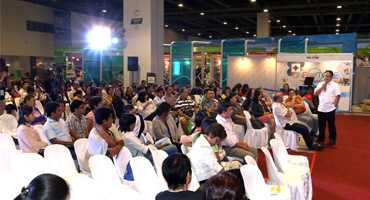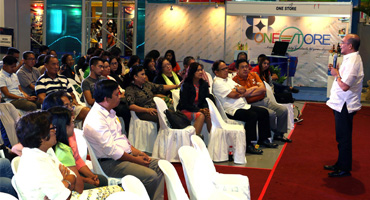The issue on coconut scale insect (CSI) or cocolisap, the most devastating pest ever faced by the coconut industry, once more takes the center stage of the SMX Convention Center, during this year’s National Science and Technology Week (NSTW).
Themed Coping with Cocolisap, the forum, a sequel to last year’s forum when the CSI onslaught was on its peak, aimed to promote greater awareness on the said invasive pest and to inform the public on what the government has done to address the voracious pest.
The forum likewise served as a venue to present the various approaches towards a more effective management of the said pest as discussed by concerned agencies. 
Acting as the forum’s resource persons were: Atty. Romulo N. Arancon, Jr., Administrator, Philippine Coconut Authority (PCA); Ms. Erlene Manohar, Officer-in-Charge, PCA, Region IV; Dr. Barbara L. Caoili, Professor, Crop Protection Cluster (CPC), College of Agriculture-University of the Philippines Los Baños (CA-UPLB); Dr. Mario V. Navasero, Scientist, National Crop Protection Cluster (CPC-CA-UPLB) and Dr. Jocelyn E. Eusebio, Director, Crops Research Division (CRD), Philippine Council for Agriculture, Aquatic and Natural Resources Research and Development of the Department of Science and Technology (DOST-PCAARRD).
Secretary Francis Pangilinan of the Office of the Presidential Assistant for Food Security and Agricultural Modernization served as the forum’s keynote speaker. In a message delivered for him by PCA Administrator Mr. Romulo N. Arancon, Jr., Pangilinan underscored the role of science and technology and the collaborative efforts of concerned agencies in addressing CSI.
Ms. Erlene Manohar explained that CSI, a sap-sucking insect, causes progressive yellowing of the older leaves. Once infested with CSI, the leaves eventually dry due to loss of sap. According to her, nuts can also be infested and pest can fully invade the young nut.
In a jump spread pattern, the pest was observed to transfer to distant areas. This was attributed to the movement of infested planting materials and wind direction, among other possible factors.
CSI was also further examined through Dr. Caoili’s presentation on “CSI species identification through DNA barcodes.” She explained the value of the precise identification of the insect pest in establishing the most appropriate and cost-effective control measure.
To illustrate how fast the pest could spread, Ms. Manohar said that as of May 2014, there was an estimated 1.1 M coconut trees infested with CSI in CALABARZON, based on a survey conducted by PCA from 2012-2014. This increased to 2.1 million trees in June, and 2.6 million trees in August of the same year.
Dr. Jocelyn E. Eusebio who presented the Integrated R&D Program on CSI Management explained that the pest spreads northeast at the rate of 0.4km/month.
Acting swiftly on the CSI concern, the government took emergency actions. Foremost of these actions were emergency administrative measures such as the issuance of Executive Order 169 and the creation of the Coconut Scale Insect Emergency Actions Program (CSIEAP).
Executive Order 169 established emergency measures to control and manage the spread and damage of Aspidiotus rigidus in the Philippines. It also designated PCA as lead agency for the purpose.
Meanwhile, CSIEAP’s efforts focused on a 60-day contracted application of science-based IPM treatment protocol, establishment of quarantine, collaborations between the PCA and the concerned local government units, and quick response actions.
These quick response actions consist of pruning of infested leaves and chopping; trunk injection of systemic insecticide; spot spraying of organic pesticides; production and release of biocontrol agents; fertilization, replanting and intercropping; and establishment of quarantine checkpoints.
Ms. Manohar reported that the mass production and inundative releases of natural enemies or biocon agents remain as the priority in IPM protocol.
Administrator Arancon, Jr. said that a total of 956,909 biological control agents (855,459 predators and 101,450 parasitoids) were mass produced and released to different areas in CALABARZON from 2013 to 2015.
One of these identified parasitoids is a new species of the genus Comperiella calauanica sp. n. (Hymenoptera: Encyrtidae), which is presented by Dr. Navasero. Comperiella exhibits host mutilation or host feeding behavior, resulting to additional mortality of CSI. To further determine the extent of the distribution of Comperiella, UPLB Basic Research Program funded a rapid appraisal and mapping of the parasitoid in CALABARZON from July to December 2014. 
PCAARRD funded the upgrading of the PCA and Regional Crops Protection Center (RCPC) Region IV biocon laboratories with the target of producing 80,000 biocon agents per month.
These biocon mass production laboratories, with their respective production target capacity, are situated at PCA Regional Office in Lucena City; PCA Provincial Office in Alaminos, Laguna; municipal agriculture offices in Mauban, Polilio, General Luna, and Alabat, Quezon; DA-RCPC in Los Baños, Laguna, and BPI in San Andres Manila.
The 23 quarantine checkpoints in CALABARZON led to more than 12,000 interceptions. More than 2,000 of these interceptions were found to be without the corresponding permit.
The government, according to Administrator Arancon, had spent P177 million for the treatment of more than one million three hundred thousand CSI-infested trees in 2014. This however led to the saving of 1,186,242 million trees providing the country an annual benefit of P474,496,800.
Recognizing that there is no best approach in addressing coconut scale insect, Dr. Reynaldo V. Ebora, PCAARRD Acting Executive Director, said that concerned agencies will have to work closely and PCAARRD will always be there to provide the needed support.
The CSI forum was one of the seven fora organized by PCAARRD during the National Science and Technology Week held on July 24-28 at SMX Mall of Asia, Pasay City. The fight against CSI is one of PCAARRD’s R&D initiatives in response to its commitment to Outcome One, which is the provision of science-based know-how and tools that will enable the agriculture sector to achieve global competitiveness.
Outcome One serves as DOST’s blueprint towards alleviating poverty in the agriculture and aquatic sectors as part of the government’s social contract with the Filipino people.
